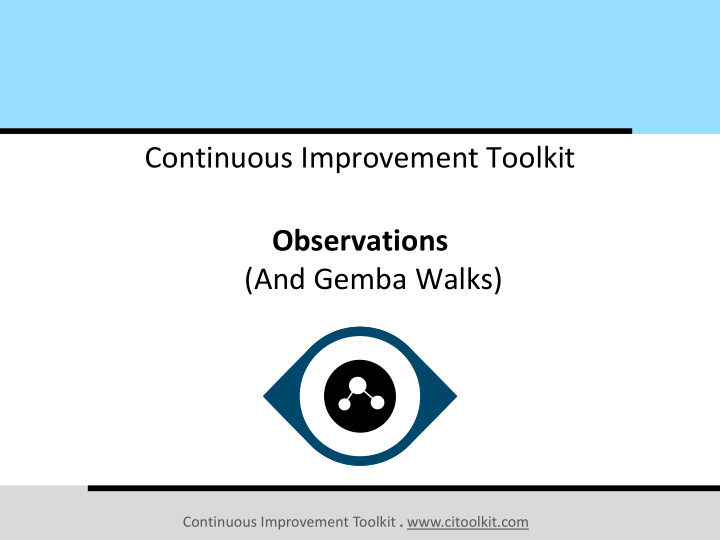



Continuous Improvement Toolkit Observations (And Gemba Walks) Continuous Improvement Toolkit . www.citoolkit.com
The Continuous Improvement Map Managing Deciding & Selecting Planning & Project Management* Risk PDPC Decision Balance Sheet Importance-Urgency Mapping Daily Planning PERT/CPM RAID Log* Force Field Analysis Cost Benefit Analysis FMEA MOST RACI Matrix Activity Networks Break-even Analysis Voting TPN Analysis Risk Assessment* SWOT Analysis Stakeholder Analysis Decision Tree Pick Chart Four Field Matrix Fault Tree Analysis Project Charter Improvement Roadmaps Critical-to Tree QFD Portfolio Matrix Traffic Light Assessment PDCA Policy Deployment Gantt Charts DMAIC Paired Comparison Matrix Diagram Kano Analysis Lean Measures Kaizen Events Control Planning Prioritization Matrix Pugh Matrix Cost of Quality* Bottleneck Analysis** A3 Thinking Standard work Document control C&E Matrix Pareto Analysis OEE KPIs Implementing Cross Training Understanding Process Yield ANOVA Chi-Square Descriptive Statistics Solutions** Cause & Effect Value Analysis Capability Indices Probability Distributions Hypothesis Testing Ergonomics Mistake Proofing Design of Experiment Gap Analysis* Multi vari Studies Histograms & Boxplots Automation Simulation TPM Confidence Intervals Reliability Analysis Graphical Analysis Scatter Plots Pull Flow Just in Time Correlation Regression Understanding MSA 5 Whys Run Charts Visual Management 5S Root Cause Analysis Performance Data Snooping Control Charts Quick Changeover Fishbone Diagram Tree Diagram* Waste Analysis Benchmarking** SIPOC* Time Value Map Sampling Morphological Analysis Process Redesign Data collection planner* How-How Diagram** Value Stream Mapping Brainstorming Spaghetti Diagram Check Sheets SCAMPER** Attribute Analysis Interviews Service Blueprints Flow Process Charts Affinity Diagram Questionnaires Relationship Mapping* Focus Groups Data Flowcharting IDEF0 Process Mapping Mind Mapping* Lateral Thinking Observations Collection Creating Ideas Designing & Analyzing Processes Suggestion systems Continuous Improvement Toolkit . www.citoolkit.com
- Observations (And Gemba Walks) A data collection method used to gather detailed information about a process or a situation. Allows to collects data in real time at the location where the data is generated. Commonly used during process improvement and change management initiatives. An inexpensive method. Only requires time and note-taking. Continuous Improvement Toolkit . www.citoolkit.com
- Observations (And Gemba Walks) Used: To gather information about a process or situation. To fully document the value stream of a process. To measure the actual performance against goals. To acquire benchmark information. To measure customers’ perception of quality. Continuous Improvement Toolkit . www.citoolkit.com
- Observations (And Gemba Walks) An Observation: Allows to better understand the process and the many factors involved: • Cycle times. • Yield rates. • Items in queue. • Recourse availability. • Etc. Continuous Improvement Toolkit . www.citoolkit.com
- Observations (And Gemba Walks) Example - Process Observation Form: Process: Observer: Observation date: Purpose of observation: Step # Process step VA, NVA Cycle time Yield Process map/drawings: or ENVA (AVG) (AVG) Total time: Remarks/improvement opportunities: Continuous Improvement Toolkit . www.citoolkit.com
- Observations (And Gemba Walks) Also used to measure customers’ perception of quality on products and services. Helps to identify the customer satisfaction level. Provides insights for improving products, services and processes. • By watching how the customer is using the product or service. Train the observers and ensure they leave a good impression on the customers Continuous Improvement Toolkit . www.citoolkit.com
- Observations (And Gemba Walks) Example - Customer Observation Form: Customer: Observer: Observation date: Time entered: Time exited: Store/location: Purpose of observation: Product Product description Stock level Time to Complaints handling # process order (Cases and minutes) Exchange: Payment: Service: Remarks/improvement opportunities: Continuous Improvement Toolkit . www.citoolkit.com
- Observations (And Gemba Walks) Gemba: A Japanese term that means “ the real place ” Refers to the place where value is created within the value stream. Continuous Improvement Toolkit . www.citoolkit.com
- Observations (And Gemba Walks) Gemba: It could be: • The factory floor. • The sales floor. • The construction site • Where there is a direct interaction between the service provider and the customer. Continuous Improvement Toolkit . www.citoolkit.com
- Observations (And Gemba Walks) Gemba Walks: An activity that takes an observer to see the actual process at the actual place. Allows walkers to gain valuable insights on how to reduce existing waste and safety hazards. Allows to discover where improvement opportunities exist. Leaders are highly encouraged to regularly walk the process in their workplace and apply Kaizen or other improvement initiatives where necessary. Continuous Improvement Toolkit . www.citoolkit.com
- Observations (And Gemba Walks) Gemba Walks: Gemba walkers should focus on something that is moving through the process: • A product. • An application. • A work order. They should not focus on the people who are working on the process. The goal is to find out what is really happening. Not what is suppose to happen. • Not whether people are following procedures or not. • Continuous Improvement Toolkit . www.citoolkit.com
- Observations (And Gemba Walks) How to Conduct an Observation: Clearly define the purpose of the observation. Prepare an observation form. Review procedures, product information, etc. Get permission to conduct the observation sessions and talk to the people there. Plan your observation including time, location and observers. Conduct the observation and walk the process. Collect data, observe actual practices and interview people. Take time to document important ideas and findings. Process and analyze the data. Continuous Improvement Toolkit . www.citoolkit.com
- Observations (And Gemba Walks) Further Information: Sometimes there is a need to schedule multiple observation sessions so that you can capture the variation in the process (when measuring the cycle time, for instance). Combining observation with photography can lead to even richer information and adds much interest to the work. Gemba walk is very similar to MBWA (Management by Walking Around). Continuous Improvement Toolkit . www.citoolkit.com
Recommend
More recommend